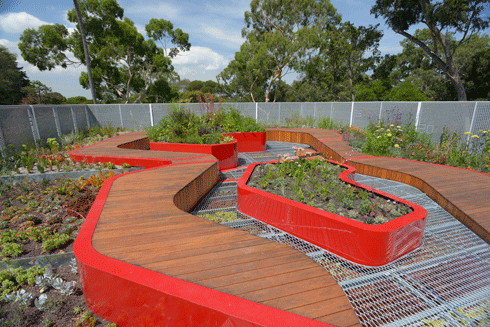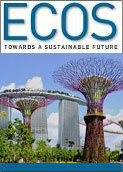
|
Published: 4 March 2013
Melbourne gets serious about green roofs
The University of Melbourne and the City of Melbourne have joined forces to launch Australia’s largest green roof research and outreach project at the University's Burnley Campus near the inner suburb of Richmond.

|
|
Green roofs act as a sponge reducing storm water runoff and potential flooding while lowering local temperature through evaporative cooling. Credit:
University of Melbourne
|
The Burnley Green Roofs Project will determine the best plant species and soils to use on city roofs, demonstrate how green roofs can use stormwater and reduce building energy use and improve the cityscape.
The project includes a large demonstration roof consisting of 14 different green roof types made up of distinct planting zones, irrigation and growing treatments; a research roof, dedicated to quantifying the environmental benefits of green roofs and plant performance; and a biodiversity roof, comprising a range of habitat features to encourage and sustain local wildlife.
The project is led by Dr Nick Williams and John Rayner from the University of Melbourne, and the roofs designed by multidisciplinary design practice HASSELL to enable small group teaching activities and demonstrate the variety of green roofs available to the building industry.
The research team at the Burnley campus was the first to develop an Australian research green roof in 2008, which, although significantly smaller, revealed a 48 per cent reduction in summer energy use.
Dr Williams said green roofs had a range of environmental benefits that could help adapt Australian cities to climate change, as well as social and economic benefits that could make denser cities more liveable and attractive.
‘Cities suffer from the urban heat island effect which makes them up to four degrees warmer than surrounding areas.’
‘Green roofs can help overcome this by reflecting the sun’s radiation and providing shade or evaporative cooling as well as dramatically reducing a building’s energy costs, trapping dust and pollutants and dampening noise.’
‘Green roofs act as a sponge reducing storm water runoff and potential flooding while lowering local temperature through evaporative cooling.’
‘We also want to use the biodiversity roof to understand how city roofs can be used to provide habitat and act as stepping stones to link fragmented urban wildlife habitat. This roof includes local native plants, an intermittent stream and hollow logs for habitat.’
Despite the many benefits of green roofs, and their popularity overseas, they are not common in Australia.
‘We know that roof tops make up 17 per cent of the total land area in the city,’ said Melbourne Lord Mayor, Robert Doyle.
‘Green roofs are a tremendous opportunity to achieve savings for building owners and create attractive, usable spaces for tenants and residents. It is clear to me that successful cities in the future will be the ones that adapt quickly to what people want. And today people want to live in the city because it offers opportunities but they also want open spaces, parks and a clean environment.’
Mr Rayner said the aim of the Burnley Green Roofs Project was to illustrate what is possible, from non-irrigated succulent beds to deeper, productive vegetable gardens.
‘We wanted to display a range of plants that can be successfully grown, but many need a certain depth of growing medium. Given we can’t use a heavy soil on a roof we developed lightweight growing media, together with foam building blocks to create raised beds.
‘We also wanted to maximise the plants and vegetation on the roof while maintaining access, so there are shallow planted areas beneath grated metal walkways.’
Source: University of Melbourne



